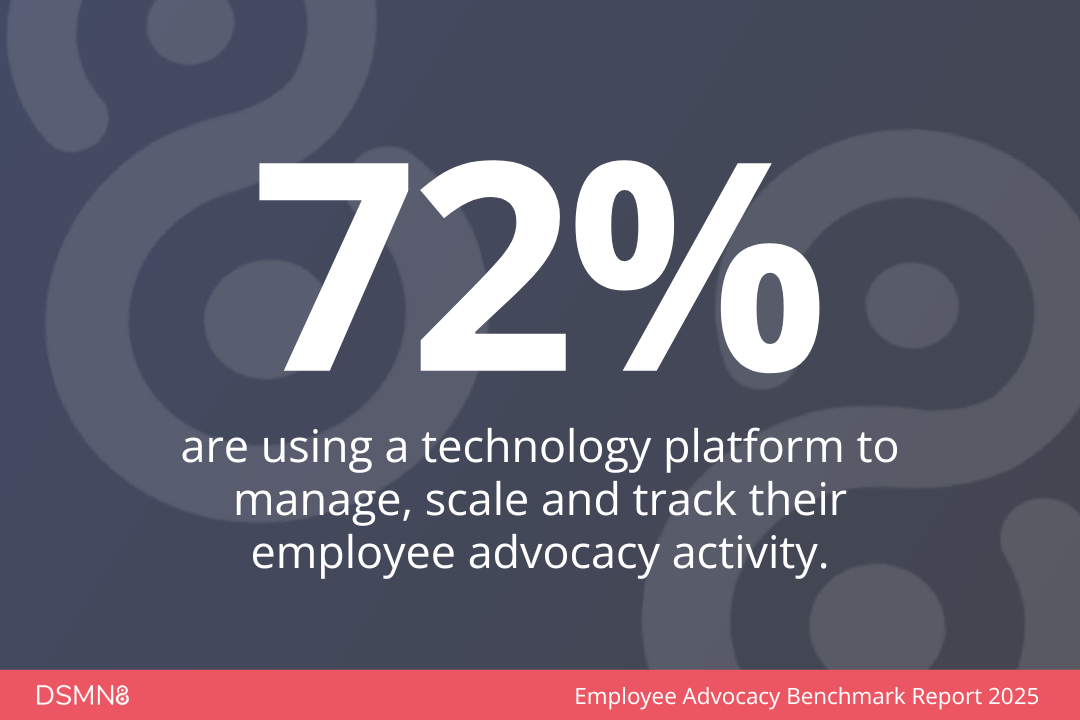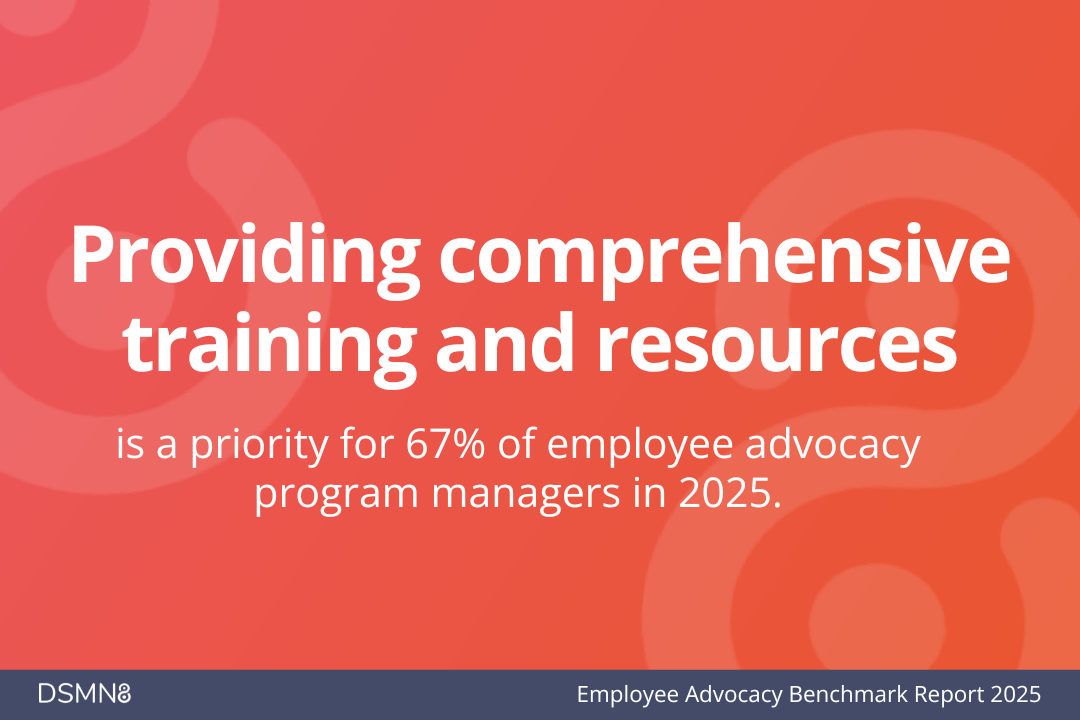
Standing out online isn’t just hard; it’s a continuous struggle. Social media algorithms are constantly shifting, driving up paid ad costs and making it harder than ever to capture attention.
Meanwhile, a world flooded with misinformation is growing weary of in-your-face brand messaging.
The result? Businesses are scrambling to engage in a landscape where authenticity is the new currency and trust is in short supply.
This is where employee advocacy comes in—a transformative approach reshaping communication strategies. Organizations are turning to their most powerful voices—their employees—to cut through the noise, build trust and reduce their reliance on paid advertising.
As this approach gains momentum, benchmarks have been closely guarded… until now!
Hear from the trailblazers in employee advocacy who have been one step ahead, with over 72% of respondents from organizations with over 1,000 employees, including IBM, Capgemini, AstraZeneca, Expedia, Procter & Gamble, Lenovo, Wells Fargo, and Oracle.
Key Findings from the Employee Advocacy Benchmark Report
Let’s jump into the data and discover how 250 employee advocacy program leaders are transforming their employees into powerful brand ambassadors on social media, and how they plan to build on the opportunity in 2025.

Most organizations see employee advocacy as a key strategic initiative.
When asked ‘how important is employee advocacy to your organization?’, 61% responded ‘extremely important’ or ‘very important’.
This reveals the growing recognition of employee advocacy as a critical business strategy, with nearly two-thirds of organizations surveyed placing it at the forefront of their priorities.
23% are generating a cost-per-click of under $1 from employee shares.
These results reveal the cost-effectiveness of employee advocacy, especially when compared with traditional advertising methods.
It’s no surprise then, that more organizations than ever are prioritizing employee advocacy as a key marketing strategy over paid social.
96% of employees believe posting on social media has positively influenced their careers.
Most respondents believe that posting on social media has positively influenced their careers, with 43% reporting a ‘Significant’ impact, 38% a ‘Moderate’ impact, and 15% a ‘Slight’ impact.
This underscores the dual value of advocacy programs, driving organizational goals while simultaneously boosting individual professional development and visibility.

32% of employee advocates have not received formal training or a social media policy.
Despite the growing importance of employee advocacy and the results being generated, nearly a third of organizations are not currently providing training or social media guidelines.
This reflects a missed opportunity to maximize program effectiveness, and a clear opportunity for improvement.
How Employee Advocacy Programs are Managed
Marketing is the most active department in employee advocacy programs.
34% of respondents said that marketing are the most active advocates, which comes as no surprise with social media forming an essential part of their role.
But the following answers make it clear that participation comes from all areas of businesses, aligning with company-wide program objectives:
-
24% sales and business development.
-
22% human resources and employer branding.
-
5% executive leadership.
-
3% public relations and corporate communications.
-
2% finance and accounting.
-
+ 7 other departments at <11%.

72% are using technology to manage their employee advocacy program.
Nearly 3/4 of respondents are using technology to manage their programs, leveraging employee advocacy platforms like DSMN8.
26% are managing these efforts manually, and 2% preferred not to say.
This dramatic result reveals that employee advocacy has become an important strategy for reaching business objectives, gaining buy-in from leadership to scale the activity with dedicated software.

75% are providing images and graphics for employees to share on social media.
While 50% of organizations encourage authentic employee-generated content, the majority make participation as easy as possible by providing ready-to-share content.
Images or graphics are the most popular choice, followed by text posts and articles (74%) and video content (68%). 22% provide audio content, and 19% create interactive content such as quizzes, polls and surveys.
The Impact of Employee Advocacy
34% say the biggest impact of an advocacy program is increased employee engagement.
While the most common objectives of employee advocacy tend to be marketing and sales focused, the biggest impact according to 34% of respondents is actually increased employee engagement.
The remaining answers are as follows:
- 26% enhanced brand awareness.
- 13% performance wins vs the algorithm.
- 8% reduced time to hire.
- 7% driving inbound leads and sales.
- 7% improved company culture and morale.
This emphasizes how empowering employees to become advocates enables them to feel closer to your organization’s values and objectives, impacting company culture as a whole. It’s not just for marketing!

52% say that brand awareness is the biggest benefit of employee advocacy.
Over half of organizations identified increased brand awareness as the primary benefit of their employee advocacy program.
This aligns with the most common program goal according to respondents: enhancing brand awareness and visibility, revealing the effectiveness of employee voices on social media.
Additional benefits recorded by respondents:
- 19% expanded reach and audience engagement.
- 10% enhanced employee engagement.
- 9% strengthened brand credibility.
- 5% improved talent acquisition and retention.
- + 3 more benefits at <5%.
The Future of Employee Advocacy
Looking towards the future, and employee advocacy shows no signs of slowing down.
The majority of participating organizations are planning to scale their programs in 2025, further capitalizing on the opportunity presented.
Here’s how 👇

How are organizations intending to boost employee advocacy in 2025?
When asked how they are planning to boost employee advocacy in 2025, respondents shared a variety of strategic methods to scale the program, increase employee engagement, and make it easy to participate.
The biggest area that employee advocacy program managers are looking to increase is leadership involvement and support, with nearly 3/4 stating this is a priority. With the influence that executives wield internally and on social media (particularly LinkedIn), this is not surprising at all.
- 73% encourage leadership involvement and support.
- 67% provide comprehensive training and resources.
- 57% highlight success stories and best practices.
- 48% offer incentives or rewards for participation.
- 45% foster a culture of sharing and collaboration.
- 43% provide a wider range of content.
- 34% improve feedback mechanisms.
- 30% develop targeted communication campaigns.
- 29% streamline sharing with user-friendly tools.
About The Study
The Employee Advocacy Benchmark Study 2025 was conducted from May 27, 2024 to August 31, 2024 with 252 respondents.
45% of respondents have Senior Managerial or Managerial roles.
The majority of respondents have Marketing roles (64%), followed by HR and Employer Branding (17%), Public Relations (4%), Finance (2%) and IT (2%). + 8 other functions at <11%.
The largest group of respondents work in the Technology Industry (32%), 10% Professional Services, 9% Advertising and Marketing, 6% Finance, 6% Manufacturing and 4% Telecommunications. + 21 other industries at <33%.
Most organizations have over 1,000 employees: 36% 10,000+, 13% 2,500-5,000, 13% 1,000-2,500, 10% 5,000-10,000, 9% 50-250 and 7% 500-1,000. + 3 other sizes at <12% total.
Respondents were primarily based in the US (41%), followed by UK (16%), France (7%), Germany (5%), Canada (4%) and Netherlands (4%). + 23 other countries at <23% total.
Emily Neal
SEO and Content Specialist at DSMN8. Emily has 10 years experience blogging, and is a pro at Pinterest Marketing, reaching 1 million monthly views. She’s all about empowering employees to grow their personal brands and become influencers.


